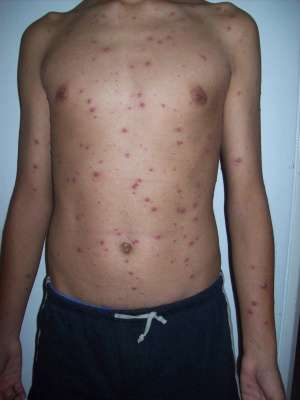Varicella
Background
- Caused by varicella zoster virus causing varicella (chicken pox) and later zoster (Shingles)
- Contagious until last lesion crusts over
Clinical Features

Male with varicella rash: lesions in various stages of development

Classic blister during early stage of lesion development
- Pruritic generalized vesicular exanthem with mild systemic manifestations
- Usually affects children <10y
Rash
- Starts on trunk or scalp as pruritic, red macules, spreads to extremities
- Within 24hr rash becomes vesicular (on erythematous base)
- Palms/soles spared
- Lesions in various stages of development
Complications
- Can include encephalitis, otitis media, pneumonia, hepatitis, strep/staph superinfection of ruptured vesicles
- Perinatal infection in neonates may develop serious illness
Differential Diagnosis
Vesiculobullous rashes
Febrile
- Diffuse distribution
- Varicella
- Smallpox
- Disseminated gonococcal disease
- DIC
- Purpural fulminans
- Localized distribution
Afebrile
- Diffuse distribution
- Bullous pemphigoid
- Drug-Induced bullous disorders
- Pemphigus vulgaris
- Phytophotodermatitis
- Erythema multiforme major
- Bullous impetigo
- Localized distribution
Varicella zoster virus
- Varicella (Chickenpox)
- Herpes zoster (Shingles)
- Herpes zoster ophthalmicus
- Herpes zoster oticus (Ramsay Hunt syndrome)
Evaluation
- Typically made on clinical features
Management
Supportive Care
- Tylenol, antihistamine, oatmeal baths
- Avoid aspirin in young children due to the risk of Reye syndrome
Antivirals
- Routine use of antiretrovirals for uncomplicated cases in immunocompetent children is not recommended [1]
- However, evidence shows decreased days of fever and number of lesions[2]
AAP recommends antiviral treatment (within 24hrs) for patients at risk of increased illness severity:
- Any patient older than 12 years of age
- Patients with chronic cutaneous or pulmonary disorders
- Patients receiving long-term salicylate therapy
- Patients receiving short, intermittent, or aerosolized courses of corticosteroids
Other cases to consider acyclovir
Immunocompetent Adult
- Acyclovir 800mg PO q6hrs daily x 5 days OR
- Valacyclovir 1000mg PO q8hrs daily x 14 days OR
- Famiciclovir 500mg PO q8hrs x 14 days
Immunocompromised Adult
- Acyclovir 10mg/kg IV q8hrs x 7 days
At risk children <12yo child based on AAP criteria
VZIG
- Initiate VZIG alongside acyclovir for inpatient treatment of child or adult
- For immunocompromised child with exposure, give as post-exposure prophylaxis if[5]:
- Within 10 days window of exposure
- VZIG given IM as 125 IU/10 kg of body weight
- Up to max of 625 IU
- Minimum dose 62.5 IU for patients weighing ≤ 2.0 kg
- Minimum dose 125 IU for weight 2.1 - 10.0 kg
- VZIG may prolong incubation period ≥1 week
- Must have patient closely follow up for signs and symptoms for 28 days after exposure
- If signs or symptoms of varicella occur, antiviral therapy must be started immediately
Disposition
Vaccine
- Introduced in 2006. Prior to introduction, incidence prior to adolescence approached 90% in US
- Vaccine is 85% effective against all disease, 90% effective against severe disease (greater than 1000 lesions)
- Typically given at age 5 in USA
- Post-exposure prophylaxis:
- Ideally given within 3-5 days of exposure in immunocompetent patients
- If immunocompromised patient is being given VZIG, varicella vaccine should be administered ≥5 months after VariZIG administration[6]
See Also
Pediatric Rashes
References
- Arvin AM: Antiviral therapy for varicella and herpes zoster. Semin Pediatr Infect Dis 2002; 13:12.
- Klassen TP, et al. Acyclovir for treating varicella in otherwise healthy children and adolescents. Cochrane Database Syst Rev. 2005; (4):CD002980.
- Drugs for non-HIV viral infections. Treat Guidel Med Lett. 2007; 5(59):59-70.
- CDC Chicken pox acyclovir treatment
- CDC. MMWR - updated recommendations for use of VariZIG - United States, 2013. July 19, 2013 / 62(28);574-576.
- CDC. Prevention of varicella: recommendations of the Advisory Committee on Immunization Practices (ACIP). MMWR 2007;56(No. RR-4).
This article is issued from
Wikem.
The text is licensed under Creative
Commons - Attribution - Sharealike.
Additional terms may apply for the media files.